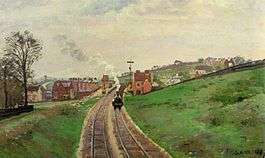Crystal Palace and South London Junction Railway
| Crystal Palace and South London Junction Railway | |
|---|---|
|
Lordship Lane Station, an intermediate station on the Crystal Palace and South London Junction Railway, by Camille Pissarro. | |
| Overview | |
| Type | Commuter rail |
| Status | Closed |
| Locale | Greater London |
| Termini |
Nunhead Crystal Palace High Level |
| Operation | |
| Opened | 1865 |
| Closed | 1954 |
| Operator(s) | British Railways Southern Region |
| Technical | |
| Number of tracks | 2 |
| Track gauge | 4 ft 8 1⁄2 in (1,435 mm) |
| Crystal Palace and South London Junction Railway | ||||||||||||||||||||||||||||||||||||||||||||||||||||||||||||||||||||||||||||||||||||
|---|---|---|---|---|---|---|---|---|---|---|---|---|---|---|---|---|---|---|---|---|---|---|---|---|---|---|---|---|---|---|---|---|---|---|---|---|---|---|---|---|---|---|---|---|---|---|---|---|---|---|---|---|---|---|---|---|---|---|---|---|---|---|---|---|---|---|---|---|---|---|---|---|---|---|---|---|---|---|---|---|---|---|---|---|
Legend
| ||||||||||||||||||||||||||||||||||||||||||||||||||||||||||||||||||||||||||||||||||||
The Crystal Palace and South London Junction Railway was built by the London, Chatham and Dover Railway from Nunhead to Crystal Palace High Level to serve the Crystal Palace after the building was moved to the area that became known as Crystal Palace from its original site in Hyde Park.
History

The branch line had a chequered history, linked to the Crystal Palace's own precarious financial position, with two periods of closure. Wartime economies led to the line closing from 1917 to 1919. After this first closure, trains from Holborn Viaduct railway station in the City were not reinstated. However, the branch was electrified, as part of a Southern Railway scheme, on 12 July 1925. After electrification all trains operated to Blackfriars and Holborn Viaduct.
Following the destruction of the Crystal Palace by fire in 1936, the line lost most of its original function of carrying visitors to events in the Palace. Manpower shortages led to a second closure from 1944 to 1946. When services were reintroduced they were very lightly used, and the line finally closed on 20 September 1954. The track was lifted in 1956.
Lordship Lane station has found ongoing fame as the subject of one of Camille Pissarro's finest small-scale pictures.
Although much of the route of the railway has now been lost to residential development, it can be traced in places. Architectural features remain such as the ornamental portal of the Paxton Tunnel just north of the terminus. Part of the route adjacent to the Horniman Museum and Gardens is now a 'Railway Nature Trail', maintained for the museum by the Trust for Urban Ecology. The section between Cox's Walk footbridge and northern entrance to the Crescent Wood tunnel is managed by the London Wildlife Trust as the Sydenham Hill Wood nature reserve.
In the early 1990s, a local amenity group, Friends of the Great North Wood, produced a walking leaflet entitled From the Nun's Head to the Screaming Alice describing a route that closely follows the line. ('Screaming Alice' was Cockney rhyming slang for Crystal Palace.) The walk continues from the site of Crystal Palace High Level past the Crystal Palace Museum to the remaining Crystal Palace railway station (formerly Crystal Palace Low Level).
Stations
The line served the following stations:
- Nunhead
- Honor Oak (closed)
- Lordship Lane (closed)
- Upper Sydenham (closed)
- Crystal Palace High Level (closed)
Crystal Palace High Level was in competition with Crystal Palace Low Level station for passenger traffic to the Crystal Palace.
External links
Further reading
- Crystal Palace (High Level) and Catford Loop by V Mitchell & K Smith, Middleton Press, 1991
- The Railway through Sydenham Hill Wood, From the Nun's Head to the Screaming Alice by Mathew Frith, The Friends of the Great North Wood and London Wildlife Trust leaflet, 1995.
- London's Local Railways by A A Jackson, David & Charles, 1978
- The Crystal Palace (High Level) Branch by W Smith, British Railway Journal 28, 1989

